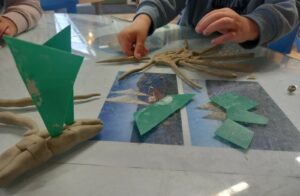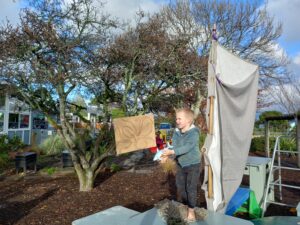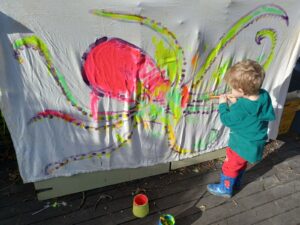
Mixed media creativity!
A major focus for the kindergartens in Te Tau Ihu o te Waka a Māui (the top of the South Island) has been extending kaiako (teachers) understanding of Te Ao Māori perspectives. Many teachers have been attending Te Ahu o Te Reo, where they are supported by local iwi to learn more about local pūrākau (stories), waiata (songs), histories and tikanga (values and practices).
This story showcases how this learning has translated back into the kindergarten context and enriched children’s learning experiences across many parts of the curriculum.

Provocations/ images inspire creations using playdough.
Kaiako at Nayland Kindergarten now regularly retell the pūrākau they have been learning with small groups of tamariki. Through repetition, tamariki have become very familiar with ‘Te Wheke a Muturangi’ (about Kupe’s journey to Aotearoa chasing a giant octopus, which links to some special places in our region), ‘Te Ika a Māui,’ (Māui fishing up the North Island whilst standing on Te Tau Ihu, or the prow of his waka), and the story of Mātua Hautere, the ancestor of Ngāti Kuia.
To help tamariki connect with the stories, they have had opportunities to explore them through play in a variety of different ways: building wheke out of uku/clay or playdough, art experiences and dramatic play inspired by an outdoor ‘waka hourua’ (double hulled waka) and giant wheke.
“I moved the outdoor climbing equipment to construct a “waka hourua”, an ocean-going waka. On board this waka we have been acting out pūrākau such as Kupe and Te Wheke (Kupe and the Giant Octopus), Te Ika a Māui (Māui’s Fish) and about Mātua Hautere (the Ngāti Kuia ancestor). These pūrākau have inspired our play: sailing, fishing, diving, cooking, singing and battles with Te Wheke. We talk about Tangaroa, the guardian of the oceans, and we always give him back the first fish we catch.” – Roger, Nayland Kindergarten kaiako

“Is this my first fish, Roger? Should I throw it back?”
Exploration of this theme continued during group visits to Teal Valley Forest Kindergarten, where mātauranga (knowledge) was shared with other kaiako and tamariki. This sharing of practice and learning stories has had a flow on affect, explained here.
Sharron from Teal Valley explains her increased awareness. By looking back over the past term, she realised that not only can the environment be a space of learning for tamariki, but also a space where kaiako can explore their own developing knowledge and share it with those around them. A great example of this exchange of knowledge started with the seed that Nayland Kindergarten planted. Roger, the kaiako, shared his learning goals of weaving the pūrākau of Matua Hautere and Kaikaiāwaro into their play space. The day of the Nayland visit, Roger and a parent helper built a waka hourua (double-hulled sailing waka).
“I learned that “Te Hoiere” was the name of Mātua Hautere’s waka. This made me curious to learn more about Mātua Hautere. It also left me wondering what other waka legends would engage the tamariki – and, you guessed it – Te Wheke and Kupe came to mind. So, the next day as a provocation, I created a giant wheke beside the waka, from bark and branches. As the week progressed, other kindergartens came to Teal Valley and these recent provocations created a context in which we (kaiako) all shared our understandings and currently learnings about the local pūrākau of Ngāti Kuia. Lorraine from Auckland Point Kindergarten surprised me by making Kaikaiāwaro (dolphin guardian and guide for both Kupe and Mātua Hautere) out of bark and shared with me her learning of the pūrākau.” Sharron, Kaiako from Teal Valley Forest Kindergarten

Collaborative and colourful Te Wheke artwork to decorate the kindergarten’s community Matariki celebration.
Banner photo: Play allows the space for tamariki to interpret and retell the stories in their own ways, to weave in their own ideas and use their imagination and experience to forge their own connections to the pūrākau.